Rear axle CHEVROLET SUBURBAN 2008 10.G User Guide
[x] Cancel search | Manufacturer: CHEVROLET, Model Year: 2008, Model line: SUBURBAN, Model: CHEVROLET SUBURBAN 2008 10.GPages: 538, PDF Size: 2.86 MB
Page 334 of 538
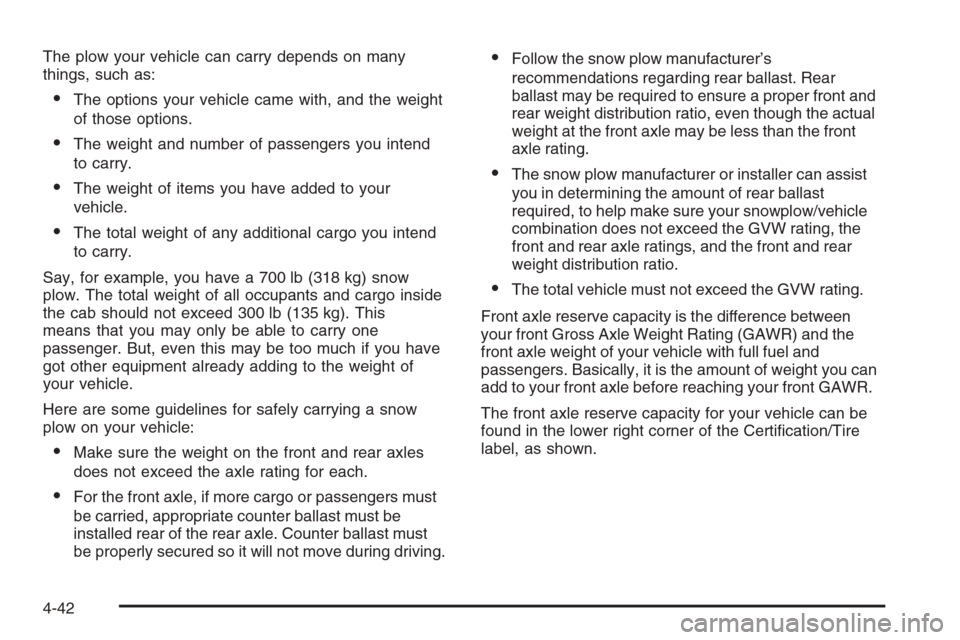
The plow your vehicle can carry depends on many
things, such as:
The options your vehicle came with, and the weight
of those options.
The weight and number of passengers you intend
to carry.
The weight of items you have added to your
vehicle.
The total weight of any additional cargo you intend
to carry.
Say, for example, you have a 700 lb (318 kg) snow
plow. The total weight of all occupants and cargo inside
the cab should not exceed 300 lb (135 kg). This
means that you may only be able to carry one
passenger. But, even this may be too much if you have
got other equipment already adding to the weight of
your vehicle.
Here are some guidelines for safely carrying a snow
plow on your vehicle:
Make sure the weight on the front and rear axles
does not exceed the axle rating for each.
For the front axle, if more cargo or passengers must
be carried, appropriate counter ballast must be
installed rear of the rear axle. Counter ballast must
be properly secured so it will not move during driving.
Follow the snow plow manufacturer’s
recommendations regarding rear ballast. Rear
ballast may be required to ensure a proper front and
rear weight distribution ratio, even though the actual
weight at the front axle may be less than the front
axle rating.
The snow plow manufacturer or installer can assist
you in determining the amount of rear ballast
required, to help make sure your snowplow/vehicle
combination does not exceed the GVW rating, the
front and rear axle ratings, and the front and rear
weight distribution ratio.
The total vehicle must not exceed the GVW rating.
Front axle reserve capacity is the difference between
your front Gross Axle Weight Rating (GAWR) and the
front axle weight of your vehicle with full fuel and
passengers. Basically, it is the amount of weight you can
add to your front axle before reaching your front GAWR.
The front axle reserve capacity for your vehicle can be
found in the lower right corner of the Certi�cation/Tire
label, as shown.
4-42
Page 336 of 538
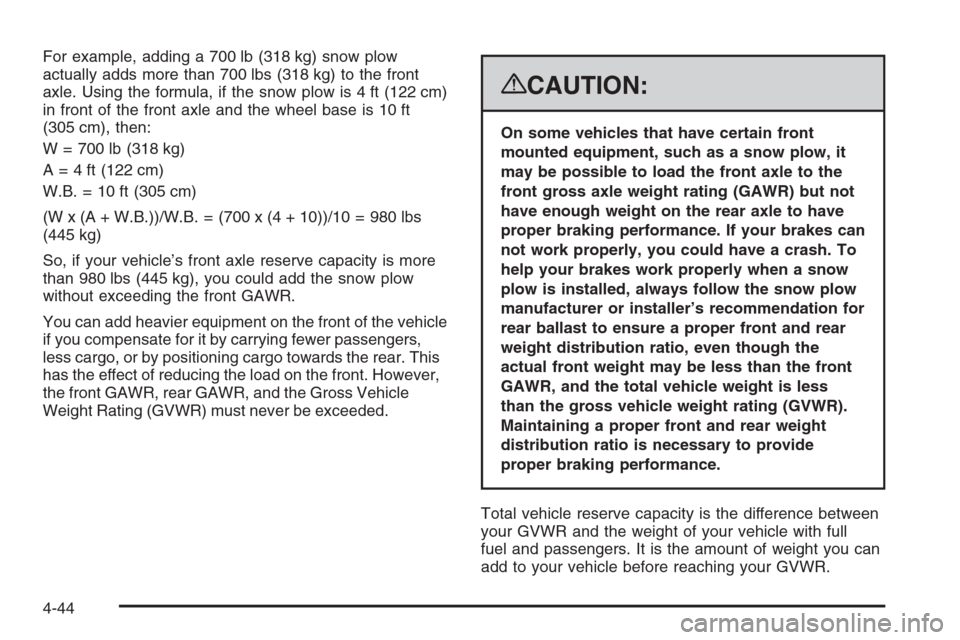
For example, adding a 700 lb (318 kg) snow plow
actually adds more than 700 lbs (318 kg) to the front
axle. Using the formula, if the snow plow is 4 ft (122 cm)
in front of the front axle and the wheel base is 10 ft
(305 cm), then:
W = 700 lb (318 kg)
A = 4 ft (122 cm)
W.B. = 10 ft (305 cm)
(W x (A + W.B.))/W.B. = (700 x (4 + 10))/10 = 980 lbs
(445 kg)
So, if your vehicle’s front axle reserve capacity is more
than 980 lbs (445 kg), you could add the snow plow
without exceeding the front GAWR.
You can add heavier equipment on the front of the vehicle
if you compensate for it by carrying fewer passengers,
less cargo, or by positioning cargo towards the rear. This
has the effect of reducing the load on the front. However,
the front GAWR, rear GAWR, and the Gross Vehicle
Weight Rating (GVWR) must never be exceeded.
{CAUTION:
On some vehicles that have certain front
mounted equipment, such as a snow plow, it
may be possible to load the front axle to the
front gross axle weight rating (GAWR) but not
have enough weight on the rear axle to have
proper braking performance. If your brakes can
not work properly, you could have a crash. To
help your brakes work properly when a snow
plow is installed, always follow the snow plow
manufacturer or installer’s recommendation for
rear ballast to ensure a proper front and rear
weight distribution ratio, even though the
actual front weight may be less than the front
GAWR, and the total vehicle weight is less
than the gross vehicle weight rating (GVWR).
Maintaining a proper front and rear weight
distribution ratio is necessary to provide
proper braking performance.
Total vehicle reserve capacity is the difference between
your GVWR and the weight of your vehicle with full
fuel and passengers. It is the amount of weight you can
add to your vehicle before reaching your GVWR.
4-44
Page 346 of 538
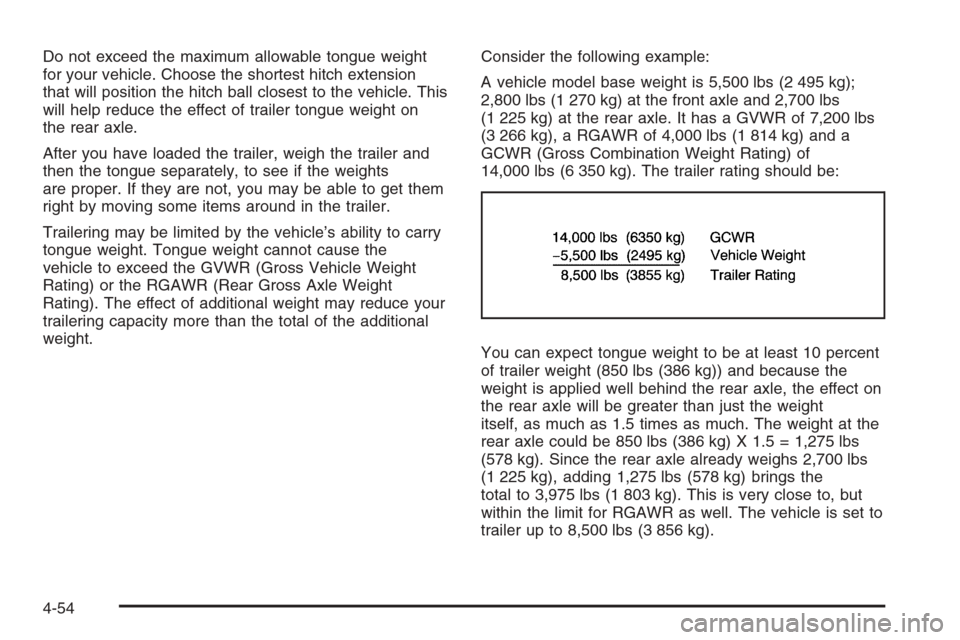
Do not exceed the maximum allowable tongue weight
for your vehicle. Choose the shortest hitch extension
that will position the hitch ball closest to the vehicle. This
will help reduce the effect of trailer tongue weight on
the rear axle.
After you have loaded the trailer, weigh the trailer and
then the tongue separately, to see if the weights
are proper. If they are not, you may be able to get them
right by moving some items around in the trailer.
Trailering may be limited by the vehicle’s ability to carry
tongue weight. Tongue weight cannot cause the
vehicle to exceed the GVWR (Gross Vehicle Weight
Rating) or the RGAWR (Rear Gross Axle Weight
Rating). The effect of additional weight may reduce your
trailering capacity more than the total of the additional
weight.Consider the following example:
A vehicle model base weight is 5,500 lbs (2 495 kg);
2,800 lbs (1 270 kg) at the front axle and 2,700 lbs
(1 225 kg) at the rear axle. It has a GVWR of 7,200 lbs
(3 266 kg), a RGAWR of 4,000 lbs (1 814 kg) and a
GCWR (Gross Combination Weight Rating) of
14,000 lbs (6 350 kg). The trailer rating should be:
You can expect tongue weight to be at least 10 percent
of trailer weight (850 lbs (386 kg)) and because the
weight is applied well behind the rear axle, the effect on
the rear axle will be greater than just the weight
itself, as much as 1.5 times as much. The weight at the
rear axle could be 850 lbs (386 kg) X 1.5 = 1,275 lbs
(578 kg). Since the rear axle already weighs 2,700 lbs
(1 225 kg), adding 1,275 lbs (578 kg) brings the
total to 3,975 lbs (1 803 kg). This is very close to, but
within the limit for RGAWR as well. The vehicle is set to
trailer up to 8,500 lbs (3 856 kg).
4-54
Page 347 of 538
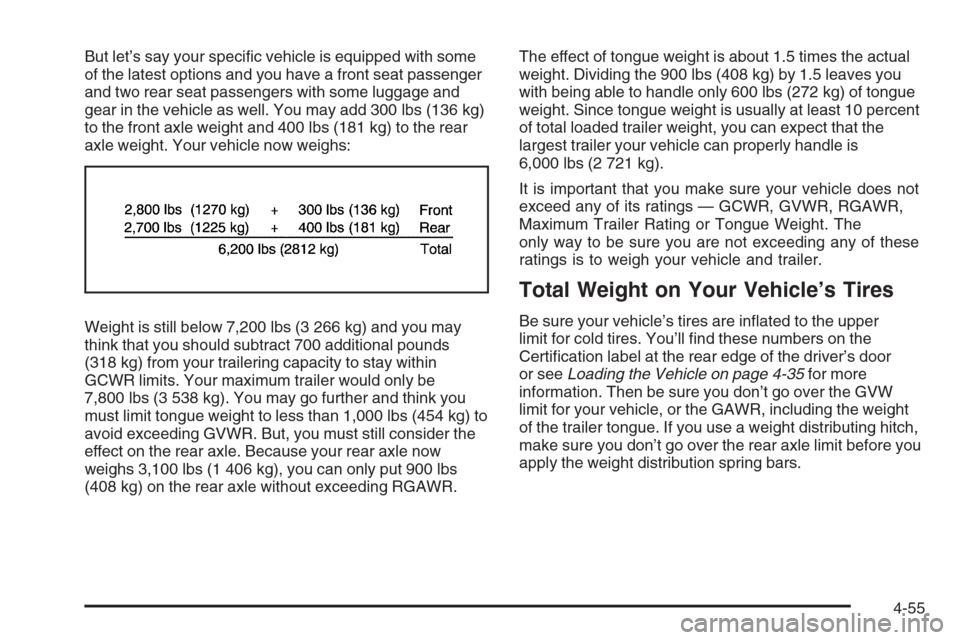
But let’s say your speci�c vehicle is equipped with some
of the latest options and you have a front seat passenger
and two rear seat passengers with some luggage and
gear in the vehicle as well. You may add 300 lbs (136 kg)
to the front axle weight and 400 lbs (181 kg) to the rear
axle weight. Your vehicle now weighs:
Weight is still below 7,200 lbs (3 266 kg) and you may
think that you should subtract 700 additional pounds
(318 kg) from your trailering capacity to stay within
GCWR limits. Your maximum trailer would only be
7,800 lbs (3 538 kg). You may go further and think you
must limit tongue weight to less than 1,000 lbs (454 kg) to
avoid exceeding GVWR. But, you must still consider the
effect on the rear axle. Because your rear axle now
weighs 3,100 lbs (1 406 kg), you can only put 900 lbs
(408 kg) on the rear axle without exceeding RGAWR.The effect of tongue weight is about 1.5 times the actual
weight. Dividing the 900 lbs (408 kg) by 1.5 leaves you
with being able to handle only 600 lbs (272 kg) of tongue
weight. Since tongue weight is usually at least 10 percent
of total loaded trailer weight, you can expect that the
largest trailer your vehicle can properly handle is
6,000 lbs (2 721 kg).
It is important that you make sure your vehicle does not
exceed any of its ratings — GCWR, GVWR, RGAWR,
Maximum Trailer Rating or Tongue Weight. The
only way to be sure you are not exceeding any of these
ratings is to weigh your vehicle and trailer.
Total Weight on Your Vehicle’s Tires
Be sure your vehicle’s tires are in�ated to the upper
limit for cold tires. You’ll �nd these numbers on the
Certi�cation label at the rear edge of the driver’s door
or seeLoading the Vehicle on page 4-35for more
information. Then be sure you don’t go over the GVW
limit for your vehicle, or the GAWR, including the weight
of the trailer tongue. If you use a weight distributing hitch,
make sure you don’t go over the rear axle limit before you
apply the weight distribution spring bars.
4-55
Page 359 of 538
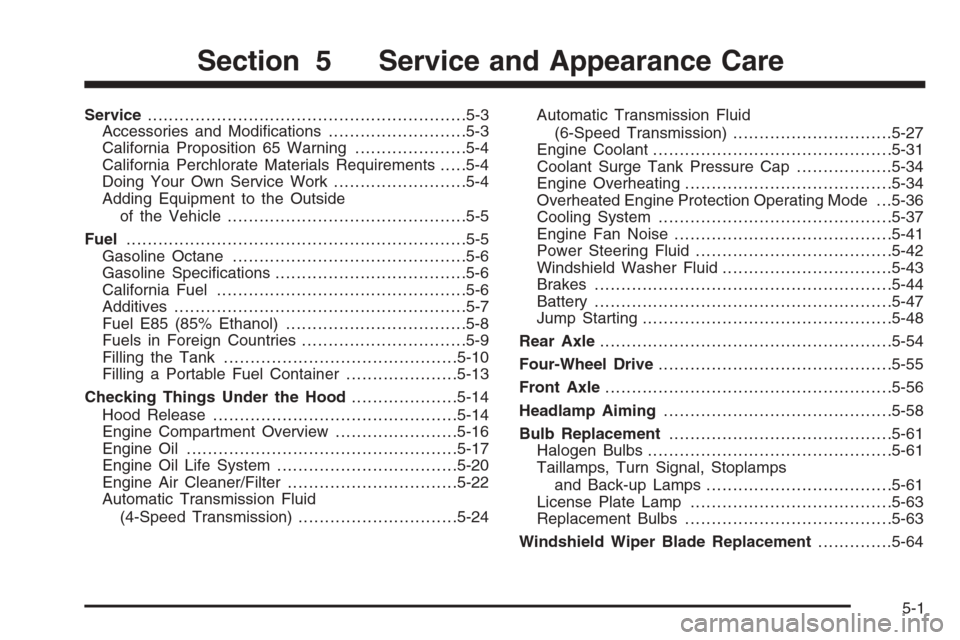
Service............................................................5-3
Accessories and Modi�cations..........................5-3
California Proposition 65 Warning.....................5-4
California Perchlorate Materials Requirements.....5-4
Doing Your Own Service Work.........................5-4
Adding Equipment to the Outside
of the Vehicle.............................................5-5
Fuel................................................................5-5
Gasoline Octane............................................5-6
Gasoline Speci�cations....................................5-6
California Fuel...............................................5-6
Additives.......................................................5-7
Fuel E85 (85% Ethanol)..................................5-8
Fuels in Foreign Countries...............................5-9
Filling the Tank............................................5-10
Filling a Portable Fuel Container.....................5-13
Checking Things Under the Hood....................5-14
Hood Release..............................................5-14
Engine Compartment Overview.......................5-16
Engine Oil...................................................5-17
Engine Oil Life System..................................5-20
Engine Air Cleaner/Filter................................5-22
Automatic Transmission Fluid
(4-Speed Transmission)..............................5-24Automatic Transmission Fluid
(6-Speed Transmission)..............................5-27
Engine Coolant.............................................5-31
Coolant Surge Tank Pressure Cap..................5-34
Engine Overheating.......................................5-34
Overheated Engine Protection Operating Mode . . .5-36
Cooling System............................................5-37
Engine Fan Noise.........................................5-41
Power Steering Fluid.....................................5-42
Windshield Washer Fluid................................5-43
Brakes........................................................5-44
Battery........................................................5-47
Jump Starting...............................................5-48
Rear Axle.......................................................5-54
Four-Wheel Drive............................................5-55
Front Axle......................................................5-56
Headlamp Aiming...........................................5-58
Bulb Replacement..........................................5-61
Halogen Bulbs..............................................5-61
Taillamps, Turn Signal, Stoplamps
and Back-up Lamps...................................5-61
License Plate Lamp......................................5-63
Replacement Bulbs.......................................5-63
Windshield Wiper Blade Replacement..............5-64
Section 5 Service and Appearance Care
5-1
Page 412 of 538
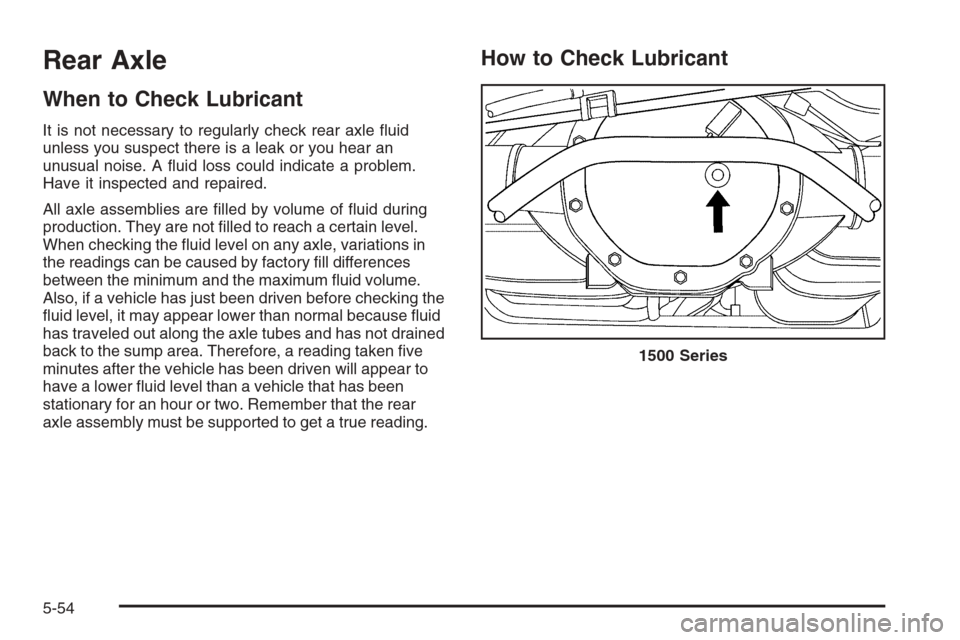
Rear Axle
When to Check Lubricant
It is not necessary to regularly check rear axle �uid
unless you suspect there is a leak or you hear an
unusual noise. A �uid loss could indicate a problem.
Have it inspected and repaired.
All axle assemblies are �lled by volume of �uid during
production. They are not �lled to reach a certain level.
When checking the �uid level on any axle, variations in
the readings can be caused by factory �ll differences
between the minimum and the maximum �uid volume.
Also, if a vehicle has just been driven before checking the
�uid level, it may appear lower than normal because �uid
has traveled out along the axle tubes and has not drained
back to the sump area. Therefore, a reading taken �ve
minutes after the vehicle has been driven will appear to
have a lower �uid level than a vehicle that has been
stationary for an hour or two. Remember that the rear
axle assembly must be supported to get a true reading.
How to Check Lubricant
1500 Series
5-54
Page 413 of 538
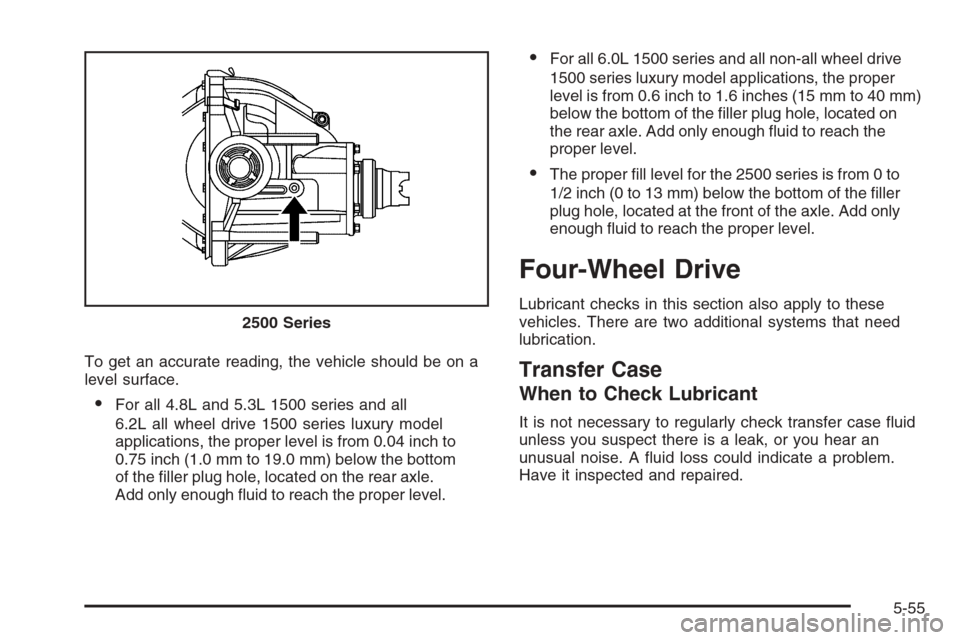
To get an accurate reading, the vehicle should be on a
level surface.
For all 4.8L and 5.3L 1500 series and all
6.2L all wheel drive 1500 series luxury model
applications, the proper level is from 0.04 inch to
0.75 inch (1.0 mm to 19.0 mm) below the bottom
of the �ller plug hole, located on the rear axle.
Add only enough �uid to reach the proper level.
For all 6.0L 1500 series and all non-all wheel drive
1500 series luxury model applications, the proper
level is from 0.6 inch to 1.6 inches (15 mm to 40 mm)
below the bottom of the �ller plug hole, located on
the rear axle. Add only enough �uid to reach the
proper level.
The proper �ll level for the 2500 series is from 0 to
1/2 inch (0 to 13 mm) below the bottom of the �ller
plug hole, located at the front of the axle. Add only
enough �uid to reach the proper level.
Four-Wheel Drive
Lubricant checks in this section also apply to these
vehicles. There are two additional systems that need
lubrication.
Transfer Case
When to Check Lubricant
It is not necessary to regularly check transfer case �uid
unless you suspect there is a leak, or you hear an
unusual noise. A �uid loss could indicate a problem.
Have it inspected and repaired. 2500 Series
5-55
Page 429 of 538
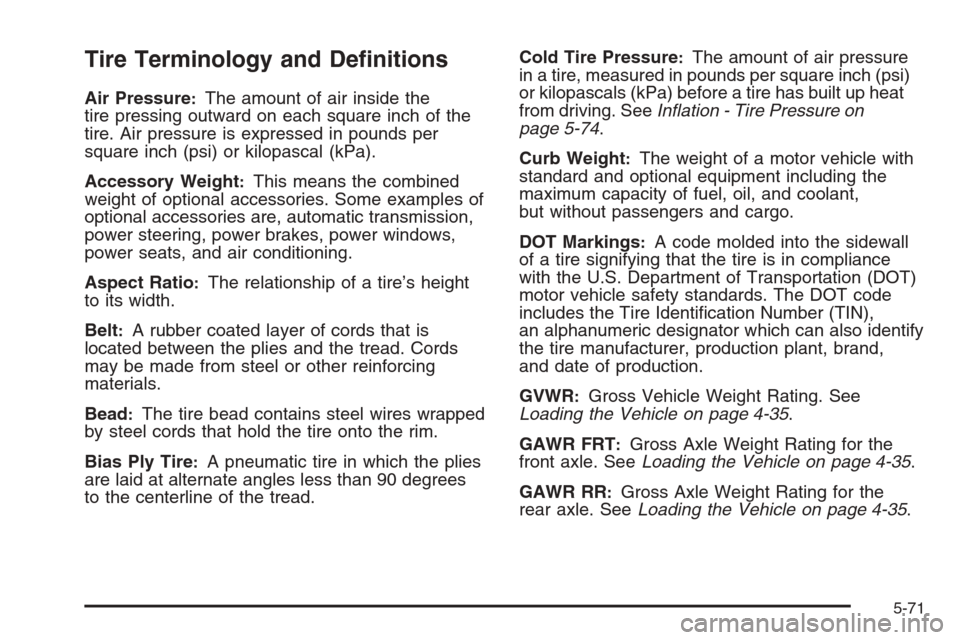
Tire Terminology and De�nitions
Air Pressure:The amount of air inside the
tire pressing outward on each square inch of the
tire. Air pressure is expressed in pounds per
square inch (psi) or kilopascal (kPa).
Accessory Weight
:This means the combined
weight of optional accessories. Some examples of
optional accessories are, automatic transmission,
power steering, power brakes, power windows,
power seats, and air conditioning.
Aspect Ratio
:The relationship of a tire’s height
to its width.
Belt
:A rubber coated layer of cords that is
located between the plies and the tread. Cords
may be made from steel or other reinforcing
materials.
Bead
:The tire bead contains steel wires wrapped
by steel cords that hold the tire onto the rim.
Bias Ply Tire
:A pneumatic tire in which the plies
are laid at alternate angles less than 90 degrees
to the centerline of the tread.Cold Tire Pressure
:The amount of air pressure
in a tire, measured in pounds per square inch (psi)
or kilopascals (kPa) before a tire has built up heat
from driving. SeeInflation - Tire Pressure on
page 5-74.
Curb Weight
:The weight of a motor vehicle with
standard and optional equipment including the
maximum capacity of fuel, oil, and coolant,
but without passengers and cargo.
DOT Markings
:A code molded into the sidewall
of a tire signifying that the tire is in compliance
with the U.S. Department of Transportation (DOT)
motor vehicle safety standards. The DOT code
includes the Tire Identi�cation Number (TIN),
an alphanumeric designator which can also identify
the tire manufacturer, production plant, brand,
and date of production.
GVWR
:Gross Vehicle Weight Rating. See
Loading the Vehicle on page 4-35.
GAWR FRT
:Gross Axle Weight Rating for the
front axle. SeeLoading the Vehicle on page 4-35.
GAWR RR
:Gross Axle Weight Rating for the
rear axle. SeeLoading the Vehicle on page 4-35.
5-71
Page 456 of 538
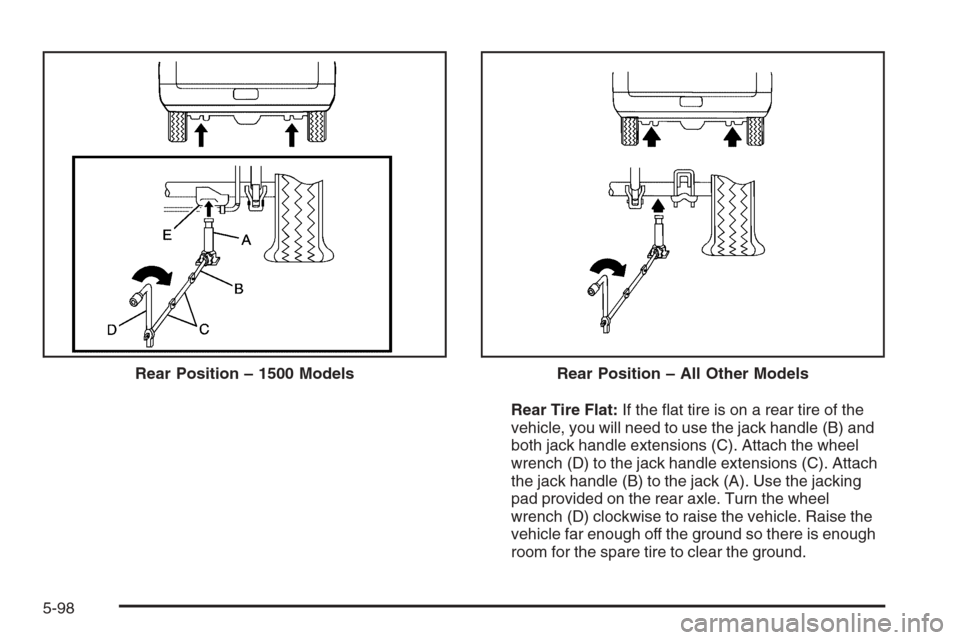
Rear Tire Flat:If the �at tire is on a rear tire of the
vehicle, you will need to use the jack handle (B) and
both jack handle extensions (C). Attach the wheel
wrench (D) to the jack handle extensions (C). Attach
the jack handle (B) to the jack (A). Use the jacking
pad provided on the rear axle. Turn the wheel
wrench (D) clockwise to raise the vehicle. Raise the
vehicle far enough off the ground so there is enough
room for the spare tire to clear the ground. Rear Position – 1500 Models
Rear Position – All Other Models
5-98
Page 494 of 538
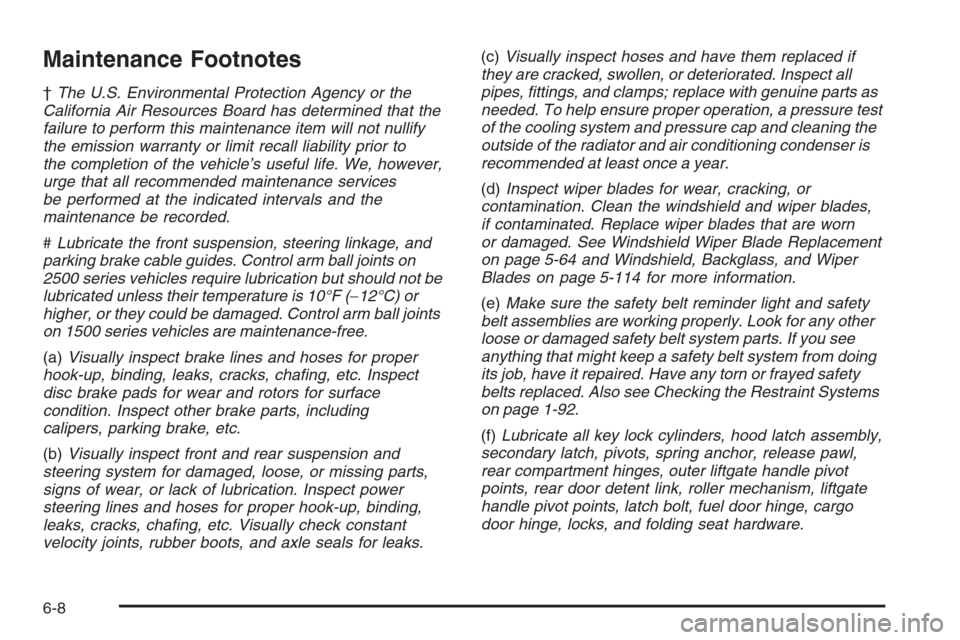
Maintenance Footnotes
†The U.S. Environmental Protection Agency or the
California Air Resources Board has determined that the
failure to perform this maintenance item will not nullify
the emission warranty or limit recall liability prior to
the completion of the vehicle’s useful life. We, however,
urge that all recommended maintenance services
be performed at the indicated intervals and the
maintenance be recorded.
#Lubricate the front suspension, steering linkage, and
parking brake cable guides. Control arm ball joints on
2500 series vehicles require lubrication but should not be
lubricated unless their temperature is 10°F (−12°C) or
higher, or they could be damaged. Control arm ball joints
on 1500 series vehicles are maintenance-free.
(a)Visually inspect brake lines and hoses for proper
hook-up, binding, leaks, cracks, chafing, etc. Inspect
disc brake pads for wear and rotors for surface
condition. Inspect other brake parts, including
calipers, parking brake, etc.
(b)Visually inspect front and rear suspension and
steering system for damaged, loose, or missing parts,
signs of wear, or lack of lubrication. Inspect power
steering lines and hoses for proper hook-up, binding,
leaks, cracks, chafing, etc. Visually check constant
velocity joints, rubber boots, and axle seals for leaks.(c)Visually inspect hoses and have them replaced if
they are cracked, swollen, or deteriorated. Inspect all
pipes, fittings, and clamps; replace with genuine parts as
needed. To help ensure proper operation, a pressure test
of the cooling system and pressure cap and cleaning the
outside of the radiator and air conditioning condenser is
recommended at least once a year.
(d)Inspect wiper blades for wear, cracking, or
contamination. Clean the windshield and wiper blades,
if contaminated. Replace wiper blades that are worn
or damaged. See Windshield Wiper Blade Replacement
on page 5-64 and Windshield, Backglass, and Wiper
Blades on page 5-114 for more information.
(e)Make sure the safety belt reminder light and safety
belt assemblies are working properly. Look for any other
loose or damaged safety belt system parts. If you see
anything that might keep a safety belt system from doing
its job, have it repaired. Have any torn or frayed safety
belts replaced. Also see Checking the Restraint Systems
on page 1-92.
(f)Lubricate all key lock cylinders, hood latch assembly,
secondary latch, pivots, spring anchor, release pawl,
rear compartment hinges, outer liftgate handle pivot
points, rear door detent link, roller mechanism, liftgate
handle pivot points, latch bolt, fuel door hinge, cargo
door hinge, locks, and folding seat hardware.
6-8